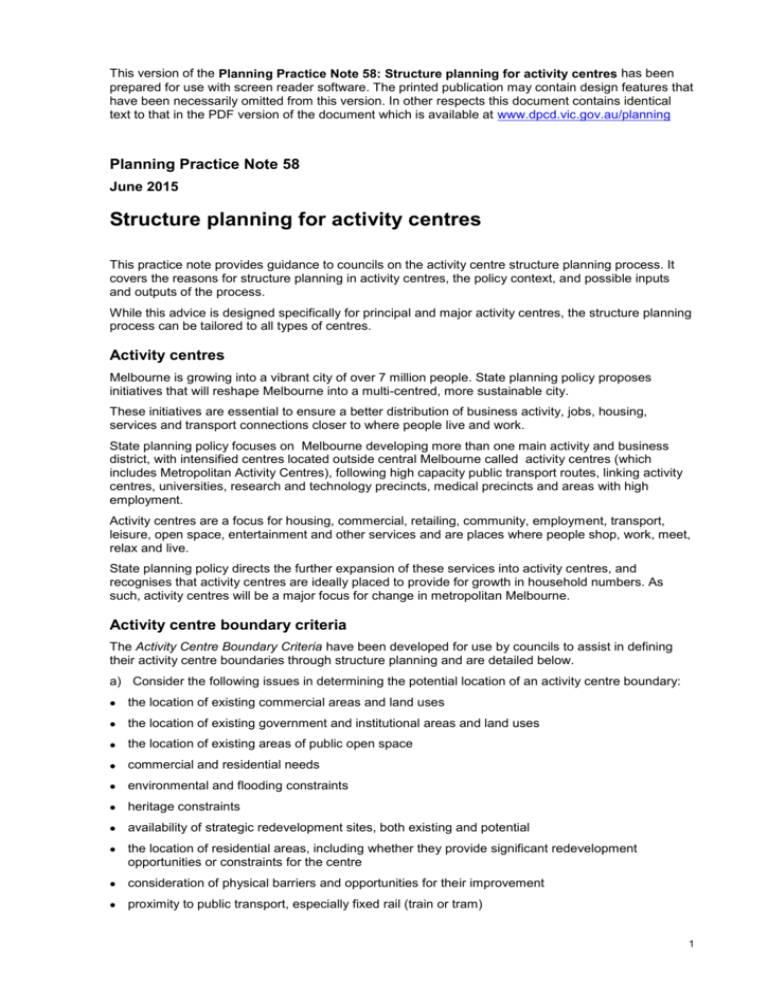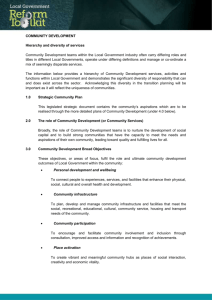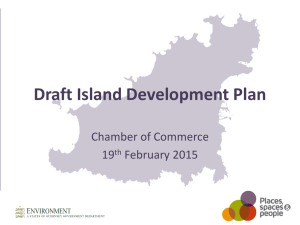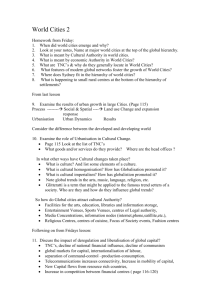Structure Planning for Activity Centres
advertisement

This version of the Planning Practice Note 58: Structure planning for activity centres has been prepared for use with screen reader software. The printed publication may contain design features that have been necessarily omitted from this version. In other respects this document contains identical text to that in the PDF version of the document which is available at www.dpcd.vic.gov.au/planning Planning Practice Note 58 June 2015 Structure planning for activity centres This practice note provides guidance to councils on the activity centre structure planning process. It covers the reasons for structure planning in activity centres, the policy context, and possible inputs and outputs of the process. While this advice is designed specifically for principal and major activity centres, the structure planning process can be tailored to all types of centres. Activity centres Melbourne is growing into a vibrant city of over 7 million people. State planning policy proposes initiatives that will reshape Melbourne into a multi-centred, more sustainable city. These initiatives are essential to ensure a better distribution of business activity, jobs, housing, services and transport connections closer to where people live and work. State planning policy focuses on Melbourne developing more than one main activity and business district, with intensified centres located outside central Melbourne called activity centres (which includes Metropolitan Activity Centres), following high capacity public transport routes, linking activity centres, universities, research and technology precincts, medical precincts and areas with high employment. Activity centres are a focus for housing, commercial, retailing, community, employment, transport, leisure, open space, entertainment and other services and are places where people shop, work, meet, relax and live. State planning policy directs the further expansion of these services into activity centres, and recognises that activity centres are ideally placed to provide for growth in household numbers. As such, activity centres will be a major focus for change in metropolitan Melbourne. Activity centre boundary criteria The Activity Centre Boundary Criteria have been developed for use by councils to assist in defining their activity centre boundaries through structure planning and are detailed below. a) Consider the following issues in determining the potential location of an activity centre boundary: the location of existing commercial areas and land uses the location of existing government and institutional areas and land uses the location of existing areas of public open space commercial and residential needs environmental and flooding constraints heritage constraints availability of strategic redevelopment sites, both existing and potential the location of residential areas, including whether they provide significant redevelopment opportunities or constraints for the centre consideration of physical barriers and opportunities for their improvement proximity to public transport, especially fixed rail (train or tram) 1 the location of existing and potential transport infrastructure including fixed rail, buses, bicycle paths, car parking areas and modal interchanges walkability – opportunities to provide for and improve walkability within 400 to 800 metres from the core of the centre (depending on topography and connectivity) consistency with State policy consistency with local policy and Municipal Strategic Statement (MSS) impacts of the boundary on other activity centre boundaries. b) In setting a boundary for an activity centre, include: sufficient land to provide for the commercial (retailing, office, fringe retailing and support activities such as entertainment) activities needed over a 15 to 20 year time frame and then into the 30-year horizon residential areas that are integrated into the activity centre or surrounded by other uses that have a strong functional inter-relationship with the activity centre even where limited development opportunities exist key public land uses that have or are intended to have a strong functional inter-relationship with the activity centre even where there are no or limited redevelopment opportunities public open space areas that have or are intended to have a strong functional inter-relationship with the activity centre. c) In setting a boundary for an activity centre, generally exclude: residential land encumbered by significant constraints (such as a Heritage Overlay) located at the edge of the activity centre. Context for structure planning Updated population predictions estimate that by 2051, Melbourne will have grown to a city of around 7.7 million people. This means that approximately 1.57 million new dwellings are likely to be needed across the Melbourne metropolitan area by 2051. Of these, an estimated additional 960,000 dwellings will need to be located in established areas (310,000 in the central sub-region and 650,000 in the balance of established suburbs) including in and around activity centres, along many tram and bus routes, close to train stations, as well as on ‘brownfield’ sites ready for urban renewal. Population growth will need to be supported by a range of sustainable travel choices including; reduced car dependency, walking, cycling, motor cycling and public transport. Structure plans help give effect to State planning policy by managing and facilitating major changes to land uses, the built form and public spaces located within activity centres. Activity centres should not be viewed in isolation to surrounding centres, but as a part of a network that maximises choice in services, retail, housing, employment and social interaction. Activity centre planning should occur within the context of a broader municipal and regional understanding of activity centres. This can be achieved through the completion of ‘municipal activity centre strategies’ and through reference to relevant regional and state strategies and research. Municipal activity centre strategies should provide general guidance on the planning of activity centres, including their role and function in the activity centre hierarchy and network of activity centres within the municipal boundary, and the surrounding region. This practice note provides a methodology for structure planning in all activity centres, including Metropolitan Activity Centres. Structure planning will not usually be required for neighbourhood centres as a municipal activity centre strategy will usually suffice. However, if a council wishes to prepare a structure plan for a neighbourhood centre, the methodology in this practice note should be followed. Planning for a neighbourhood centre should address the local characteristics, stakeholder needs, opportunities and constraints of the centre, and work undertaken should be proportionate to the role and size of the centre in the overall activity centre network. 2 Councils should also consult with the department to determine if further research and planning is required for individual neighbourhood centres, although in most cases this will remain a council responsibility. The aims of structure planning The key aims of structure planning are to plan for and develop a shared vision for the activity centre, and to identify the type and scope of change projected within the activity centre over time. The structure plan should be a tool to help manage, influence and facilitate change within individual activity centres, in accordance with the directions of State planning policy. Structure planning should: articulate the shared vision for the centre define the activity centre boundary, (see Activity centre boundary criteria section) which should be large enough to allow for future growth and manage impacts beyond the centre. It is likely that the activity centre boundary will be larger than the existing commercial areas be consistent with regional and local transport, retail, economic, social, environmental, demographic and housing roles of the centre identify precincts, themes and a preferred future character for the centre that facilitates growth and change over time provide for housing choice and diversity taking into account housing development data and housing capacity, State planning policy and the Urban Development Program provide opportunities for further retail, entertainment, office and other commercial and business services in accordance with activity centre policy in the Victoria Planning Provisions (VPP), taking into account state and regional retail projections and objectives provide for well designed and well located public spaces, (including passive and active open space) that serve the needs of all the community and visitors to the centre facilitate a pedestrian environment support greater transport mode choice provide a mobility network and traffic and carparking management that encourages and supports sustainable transport mode choices identify the optimal use of government owned land in the centre address and identify public realm and capital improvement opportunities be developed together with the community and stakeholders be developed with guidance from the metropolitan strategy and activity centre policy of the VPP and Activity Centre Design Guidelines (DSE, January 2005) outline appropriate built form outcomes in accordance with the objectives of the design and built form policy of the VPP lead to the development of a detailed implementation program of statutory and strategic initiatives, including the production of a Statutory Framework (see Implementation Program section in step 6 for details). In exceptional circumstances an activity centre may not be able to accommodate the required levels of change to meet community needs and State objectives. In these circumstances edge of centre locations may be justified as alternative locations for new and necessary development. The process for structure planning The process for preparing a structure plan will vary from centre to centre as structure planning takes into consideration the individual needs and circumstances of each centre. A typical structure planning process will generally include the steps and tasks outlined below. These may be adjusted in consultation with the department where it can be demonstrated that exceptional circumstances require an alternative approach. In the case of growth areas where an activity centre is located within a Precinct Structure Plan Area, the Precinct Structure Plan overrides the requirement for the preparation of a separate Structure Plan. 3 In this case, the Activity Centre Structure Plan should be integrated into the Precinct Structure Plan. More information is available at the Metropolitan Planning Authority website: www.mpa.vic.gov.au Some questions to consider when scoping the issues for an activity centre: What is the capacity for increased housing? How much retail and office floor space will be needed for local and regional functions and where/how should this be accommodated? How many opportunity sites are there and what can they accommodate? How many opportunity sites are available for site consolidation? What community service, open space and facility upgrades will be needed? What new access routes will be required and which modes should have priority in each street? What are the implications for State agencies and Local Government in terms of future service/infrastructure provision? How can the centre support greater transport choice? How many sites are affected by contamination? What assets does Council own/manage in the centre? Are they being used to their full potential? Stakeholders and community: adding value to the plan Effective engagement with stakeholders and the community is beneficial for a structure plan to become a reality. There are various levels of engagement to be considered during the preparation and implementation of a structure plan. As each centre is different, the type and level of engagement will depend on the individual needs of the centre and the community. It is critical to plan for stakeholder and community engagement early in the project. Effective Engagement: building relationships with community and other stakeholders kit (DSE, 2005) is a useful tool that can help to plan for engagement. The toolkit is available at www.dse.vic.gov.au/effectiveengagement Early engagement with key stakeholders will assist in understanding what their interests in the centre are and their potential to deliver or influence outcomes in the centre. It is also important to understand the commercial realities early on in the planning of the centre and to set realistic expectations for the centre and the community. This also provides the opportunity for upfront commitment from these stakeholders to ensure clear parameters are set for future development and change with regard to infrastructure/service planning and the potential for public and private investment in a centre. Examples of key stakeholders / agencies that may require early engagement include: businesses / land owners traders and their representative organisations infrastructure and service providers (for example Melbourne Water) Department of Economic Development, Jobs, Transport and Resources (transport planning, active transport, freight)) Public Transport Victoria VicRoads VicTrack Places Victoria Metropolitan Planning Authority Department of Education and Training Department of Health and Human Services Department of Environment, Land, Water and Planning. 4 Community engagement is essential for the structure plan and involves the wider community and may include targeted consultation. Community engagement is appropriate during key stages of the development and implementation of the structure plan. This will include developing a vision for the centre, scoping community and stakeholder issues, developing the plan, seeking feedback on the draft plan, and outlining how the community and stakeholders can continue to be engaged during the implementation phase. Broader community involvement at these key stages can be supplemented by ongoing involvement of key stakeholder representatives, for example through a reference group or steering committee. Community engagement can be undertaken through various methods, and it is important to ensure that the project team has the appropriate skills to plan for and undertake effective community engagement. The plan should aim to ensure that a representative community is engaged. This can be achieved by engaging the community about matters that are of interest to them, for example safety, housing choice, shopping, car parking, open space, and bicycle paths rather than focus purely on the structure plan document. The engagement plan should also clearly articulate where the community can and cannot influence decisions. Examples of different types of engagement include: interactive information displays and sessions in activity centres visiting and talking with a range of representative community groups (such as senior Victorians, people with a disability, cultural groups, youth groups, young parent groups, schools and traders groups) community newsletters web-based and interactive on-line forums targeted consultation / workshops / focus groups direct engagement with affected landowners / occupiers non-English speaking groups. The type of engagement choosen will depend on whether you are informing, consulting, involving, collaborating or empowering stakeholders and the community. These types of engagement are based on the International Association for Public Participation model IAP2 Spectrum of Public Participation at www.iap2.org In certain circumstances, a qualified facilitator may be valuable, to ensure that a representative community is engaged and to assist in resolving issues in dispute, while framing the structure plan. 5 Step 1: Project planning and establishment This step involves the following preliminary actions: Develop a project brief, carefully developing and scoping the project methodology, timelines and outputs. Establish a project team including a project steering committee. To ensure an integrated planning process, this should include internal non-planning departments of Council including engineering, economic development, urban design, community/social planning, landscaping, parks and works departments, and finance officers. The project team will further refine the project brief. Define the study area (which must be larger than existing commercially zoned areas). Identify and engage key stakeholders, including relevant community and business stakeholders and government agencies/departments. Plan for and determine appropriate community and stakeholder engagement. This should be included in the project brief, and should build on the findings of previous engagement. Develop a budget program that will provide funding sources for the project. Step 2: Background research Gather relevant data to: scope existing conditions and issues, including clearly identifying the regional commercial and community role of the centre engage with the community and stakeholders around issues that can be addressed in the development of the structure plan identify existing Local, State and Federal Government strategic work and policies that could be used as the basis for managing growth and change. This could include housing, employment, economic, social, transport or retail projections, strategies or policies identify further studies and expert analysis that is required undertake studies and collect data, such as existing conditions and potential opportunities, demographic analysis, including population projections, economic and retail analysis, urban design and built form, transport, services and infrastructure analysis brief councillors engage with government agencies, government departments, service providers and key stakeholders to determine future infrastructure, capital works, services, programs and/or any public and private investment planned in the centre. Note: It is critical for the success of the structure plan that stakeholders who may need to endorse actions in the implementation plan are engaged early in the process. This provides an opportunity for Council to discuss policy alignment and priorities with State Government and where relevant, Federal Government. Step 3: Discussion Paper From the background research, prepare a discussion paper that explores how the objectives of State planning policy will be achieved. The discussion paper should: outline the purpose of preparing the structure plan and the objectives sought identify a summary of important features, opportunities and constraints, based on an analysis of strengths, weaknesses, opportunities and threats (SWOT). This should include a detailed understanding of community and stakeholder needs for the centre identify existing built form, land uses and spatial analysis identify and analyse demographic changes and community profiling, including implications for the future of the centre set aspirations for housing, office, business mix, retail, entertainment, education and employment, taking into account housing development data and capacity requirements, economic and retail projections 6 identify the public transport network identify clear goals for transport mode share splits identify relevant transport requirements including advisory notes, practices notes, the Public Transport Guidelines for Land Use and Development, Department of Transport, 2008, and other relevant policy documents identify mobility networks for transport choices and provide support for behaviour change programs that lead to an increase in mode share. Step 4: Draft structure plan The information from, and responses to, the discussion paper must be used to prepare a draft structure plan. The draft structure plan should be concise and relevant, but detailed enough to be translated into a clear implementation program for the centre that includes statutory and strategic actions. The draft structure plan should be a maximum of 20 to 30 pages in length, including maps and diagrams. The structure plan should: clarify the role and function of the activity centre in the context of State planning policy develop a concise vision, which sets out the shared and agreed objectives for the centre identify where growth and change will occur, preferably by precinct or theme define the boundaries of the activity centre to accommodate sufficient growth consistent with State policy and the activity centre boundary criteria show the form of future development and identify suitable locations for a range of developments in and around the centre, to give clear directions about preferred locations for investment identify key opportunity sites, and provide guidance for future development identify opportunities for a range of housing types and increased residential densities, and the implications for social and physical infrastructure, commercial and community services and facilities show suitable locations for various forms of passive and active public spaces in and around the centre demonstrate that the centre can support interlinking travel choices, travel behaviour change, and an increase in sustainable mode share incorporate the public transport network and integrated transport plans where relevant identify opportunities to increase accessibility and permeability of the area, and provide support for travel behaviour change programs plan for ageing in place, and a diverse community detail how the quality and design of the public environment will be enhanced develop a program for continued improvement to and maintenance of the amenity, comfort and aesthetic qualities of the public environment within the activity centre demonstrate that the centre can accommodate projected requirements for housing, office, social and community infrastructure, business mix, retail, entertainment and employment contain a detailed implementation program including a Statutory Framework (see Implementation program section below for details) develop a budget program that will consider potential funding sources for the project implementation. Preparing the structure plan should be a collaboration between Local and State Governments. Relevant areas of government should be given an early opportunity to discuss and provide feedback on the draft structure plan including consistency of the structure plan with State planning policy and any regional studies, programs and objectives. Step 5: Final structure plan The final structure plan: must be consistent with State planning policy 7 must be based on the methodology and format of the draft structure plan must amend and update the draft structure plan where considered appropriate, following consultation with community and key stakeholders should be informed by the feedback of the department and any other relevant government agency or department must be adopted by Council should remain a maximum of 20 to 30 pages in length, including relevant maps and diagrams. Background research and discussion papers should be separate but related documents, to ensure the structure plan remains an accessible length must provide clear decision guidelines should define the implementation program and statutory framework (see Implementation program section below for details). Step 6: Implementation program Each structure plan must include or be accompanied by an implementation program. The implementation program will articulate the actions and strategies necessary to implement the structure plan. It should: be adopted by Council and be linked to the Council’s corporate plan, to ensure a whole of Council approach to the implementation of the structure plan identify the actions required to deliver the objectives of the structure plan. Include quick wins which show centre improvements, and key catalyst projects which are clearly prioritised engage the stakeholders who need to support and agree to the implementation mechanisms outlined in the plan outline where ongoing community and stakeholder engagement will be required prioritise projects define responsibilities for each project and process. Identify who is responsible for overall implementation establish an implementation team and identify key players, including where appropriate, a place manager/key council staff to drive the implementation program identify council budget requirements and other possible funding sources. The implementation team should continue to engage with infrastructure departments and agencies on the timing and priority of infrastructure and service delivery show specific time lines and key milestones for implementation define governance arrangements for the centre and the management of the plan identify any planning scheme changes needed through a statutory framework identify relevant non-statutory implementation measures such as land exchange or site consolidation, public/private partnerships, marketing and centre promotions include targets and indicators to measure progress in meeting the performance criteria in State planning policy. Statutory Framework To give greater certainty to the implementation of the vision for the centre, it is necessary to ensure that key elements are included in the planning scheme. It is important to minimise the time lag between a comprehensive engagement program to prepare the draft structure plan, and the proposed planning scheme amendments. All proposed amendments to the planning scheme should be assembled in a separate implementation section of the structure plan titled the Statutory Framework. Councils may seek to apply detailed statutory controls to: promote the appropriate development of opportunity sites encourage particular land use outcomes and development certainty 8 promote high quality architecture and urban design, for example through height controls, setback controls and other design requirements, see Planning Practice Note 60 Height and setback controls for activity centres. manage (not prohibit) development adjacent to sensitive areas such as heritage sites or adjacent residential areas. For example, Councils may seek to use a range of the following statutory controls as follows: modifications to the MSS and local policies to reflect the vision and priorities of the structure plan change of zones to encourage specific land uses to establish at various locations within an activity centre. To simplify planning in activity centres. the Activity Centre Zone (see Planning Practice Note 56 Activity Centre Zone) and tailored Development Framework should be utilised across activity centres, unless specific circumstances require the application of other VPP zones; for example a PUZ on public land (see Planning Practice note: Applying the Public Land zones, February 1999) include a Public Acquisition Overlay to secure land for public purposes include a Development Contributions Overlay to secure funding for identified priorities modify the car parking requirements of Clause 52.06 for particular land uses by applying a Parking Overlay and related schedule modify the schedule to Clause 52.01 in relation to open space requirements add reference documents including the structure plan as a reference document. Councils that have already completed structure plans that do not include a statutory framework, will need to undertake the following steps: produce a statutory framework for the activity centre; or demonstrate that the existing structure plan includes a section that fulfils the same role as a statutory framework; or demonstrate that the planning scheme already reflects the statutory priorities of the structure plan. Councils should discuss the content of the statutory framework with the department before preparing any formal proposal for planning scheme amendments. This is in addition to consultation with the department during the preparation of the structure plan. Non-statutory implementation Implementation measures other than planning scheme amendments that councils are encouraged to consider include: land assembly: purchasing, swapping or working with existing land owners to consolidate key parcels for development public land arrangements infrastructure: upgrading or providing new infrastructure that may be aligned with existing programs run by Council or other stakeholders develop a municipal multi-year asset development strategy, for the life of the structure plan partnership arrangements funding mechanisms: establishing special area/rate levies improving places: employing a Place Manager, improving the public realm and encouraging safer environments within the centre, marketing and centre management (refer to the department’s web site for more information about place management) community development: establish a community safety committee for the centre, build the capacity of traders associations, hold community festivals and events, etc. Relevant measures should be included in the implementation program. Council may contact the department for additional information regarding specific non-statutory implementation measures if required. 9 Step 7: Monitoring and review It is important to establish processes to monitor progress towards achieving the vision and objectives for the centre and to regularly review the documents prepared as part of the structure planning process. Council should nominate a responsible person who will oversee the review process. Regular reviewing of the products generated by the planning process is essential in ensuring that they remain current and relevant. This needs to take into account newly released ABS data, VIF projections, demographic analysis, housing development data, VCAT decisions, panel reports and revisions to State policy. It may be convenient for Council to review the structure plan every four years to coincide with the MSS review process. The outcomes from the MSS reviews, municipal activity centre strategies, housing development data, housing strategies, regional economic studies, data from the Urban Development Program and other relevant research documents will need to inform the review of the structure planning process. Likewise, once a structure plan is complete, it will in turn assist in the monitoring and review of these other initiatives. For example commitments by councils to deliver a minimum number of new dwellings through the housing projections and housing capacity statements may need to be reviewed as a result of actual dwelling starts as detailed in the Urban Development Program or housing development data. Further assistance The department will provide advice to councils where required throughout the entire structure planning process, including early feedback on the consistency of structure plans with State planning policy, with preparing and executing implementation programs and amendment processing. All draft structure plans should be sent to the department before production of the final structure plan. Planning publications The following publications provide best practice guidance on planning for new urban communities, statutory planning processes and drafting statutory documents (as relevant). Planning for urban communities Ministerial Direction No. 9 Metropolitan Planning Strategy Activity Centre Design Guidelines (Department of Sustainability and Environment 2005) Guidelines for Higher Density Residential Development (Department of Sustainability and Environment 2004) Safer Design Guidelines (Department of Sustainability and Environment 2005) Public Transport Guidelines for Land Use and Development (Department of Transport 2008) Cycling into the Future 2013-23 (Victorian Government December 2012) SmartRoads Network Operating Plans (Various prepared by VicRoads with each Council) Height and Setback Controls for Activity Centres Practice Note 60 (Department of Environment, Land, Water and Planning June 2015) Assessment and Response to the Report of the Advisory Committee on Activity Centre Boundaries (Minister for Planning June 2009) Activity Centre Zone Practice Note 56 (Department of Environment, Land, Water and Planning June 2015) Statutory planning processes Using Victoria’s Planning System (Department of Environment, Land, Water and Planning) Strategic Assessment Guidelines Planning Practice Note 46 (Department of Environment, Land, Water and Planning, June 2015) Using VPP tools and statutory drafting Writing Schedules VPP Practice Note (Department of Infrastructure 2000) 10 Incorporated and Reference Documents Planning Practice Note 13 (Department of Environment, Land, Water and Planning, June 2015) Further information All Planning Practice Notes and Advisory Notes are available on the department’s website: www.delwp.vic.gov.au/planning Further information in relation to planning for activity centres is available on the department’s website: www.delwp.vic.gov.au/planning © The State of Victoria Department of Environment, Land, Water and Planning 2015 This work is licensed under a Creative Commons Attribution 4.0 International licence. You are free to re-use the work under that licence, on the condition that you credit the State of Victoria as author. The licence does not apply to any images, photographs or branding, including the Victorian Coat of Arms, the Victorian Government logo and the Department of Environment, Land, Water and Planning (DELWP) logo. To view a copy of this licence, visit http://creativecommons.org/licenses/by/4.0/ Published April 2010, revised June 2015 ISBN 978-1-921607-51-6 (pdf) Disclaimer This publication may be of assistance to you but the State of Victoria and its employees do not guarantee that the publication is without flaw of any kind or is wholly appropriate for your particular purposes and therefore disclaims all liability for any error, loss or other consequence which may arise from you relying on any information in this publication. Accessibility If you would like to receive this publication in an alternative format, please telephone DELWP Customer Service Centre 136 186, email customer.service@delwp.vic.gov.au, via the National Relay Service on 133 677 www.relayservice.com.au . This document is also available in as a PDF at www.delwp.vic.gov.au/planning DOCUMENT ENDS 11








